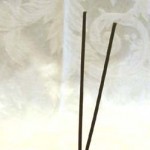Incense in the synagogue – Ask the Rabbi
Q. In some religions they go in for “bells and smells”. Why does Judaism not burn incense in the synagogue, especially since it used to be the case in the Temple?
 A. Probably the only context in which there was anything similar to incense in the synagogue was amongst some of the Chassidim, who would smoke a pipe or perfumed cigarettes before prayers; there is a suggestion that the Baal Shem Tov even said a b’rachah before smoking his lulke.
A. Probably the only context in which there was anything similar to incense in the synagogue was amongst some of the Chassidim, who would smoke a pipe or perfumed cigarettes before prayers; there is a suggestion that the Baal Shem Tov even said a b’rachah before smoking his lulke.
There is a Chassidic view that there are holy sparks of some kind in the tobacco which help to elevate a person spiritually in the same way, presumably, as the incense in the Temple provided an aroma, an aura and – from some mystical point of view – a means of elevation.
The classical commentators emphasised that it was not God who benefited from the incense, but human beings. The “sweet savours” of the Temple incense were thus designed for earth, not for heaven.
The preparation of the incense was in the hands of the family of Avtinas, who kept the details so much to themselves that they were severely criticised by the rabbis (Yoma 3:11). A Talmudic passage (K’ritot 6a) found in the Siddur – Pittum HaK’toret – is the careful rabbinic reconstruction of the requirements of the incense ritual (Ex. 30:34-38).
The abandonment of incense after the destruction of the Temple may have been part of what seems a deliberate policy to avoid emulating crucial aspects of Temple worship. The use of instrumental musical accompaniment, for instance, was not continued as a mark of mourning for the Temple; Franz Rosenzweig added that this showed that we were now living in “real”, not “ideal” time.
The Temple ritual has been largely replaced by liturgy, and many quote the words of the Psalmist, “Let my prayer be set before You as incense” (Psalm 141:2).



